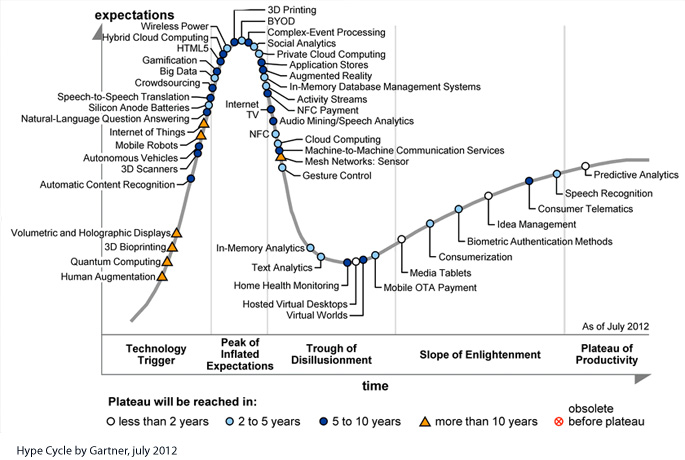It represents quite a few IT challenges to capture, store, search, structure and visualize these data. However, the real challenge lies elsewhere. In how organizations, like yourself, can extract value from it for yourself and your clients.
The opportunity big data presents
Last year we published a blog post about the enormous amount of data that is added each second of the day. In an era where people suffer from information overload we in fact embrace this data deluge as it presents us with opportunities to extract actionable information and drive competitive value.
Though a lot of these data is publicly available, free for you to mine and analyze, extracting insights from it is not that easy. This is because the data is unstructured. Applications like Byelex’ BuzzTalk solve this problem. By capturing and structuring the data that is published on news sites, blogs, journals, twitter etc (*) you can select, filter and sort through it enabling you to see the big picture of what’s happening in your industry. Since every source is enriched with meta tags you can easily drill down and explore further.
Big data and big expectations
Big data is vital for our understanding of the full universe of our business, the environment in which we operate, the market we want to conquer, the consumers, competitors, and influencers. Discovering value in big data presents a competitive advantage. Big data has a promise to keep as the expectations are sky high nowadays. Gartner has illustrated this in July 2012 in their famous Hype Cycle and plotted ‘Big Data’ just before the peak of inflated expectations reaches it’s top:

Bridging the utilization gap
Companies will be spending 66% more on Big data in the next three years according to a CMO survey. While expenditures go up, usage goes down which represents a problem when you want to extract value from your investments in Big data. According to a survey published by Oracle in 2012, 93% of executives believe their organization is losing revenue at an average rate of 14% annually as a result of not being able to fully leverage the information they collect.
As money spend doesn’t result in value extracted there seems to be a utilization gap. What could be the problem here? How can companies get value from their investments in Big data?>
Big Data is often misunderstood
Handling big data, storing big data and structuring big data requires a lot of advanced technology. In fact we are teaching computers how to read and think like humans. This requires not only IT, but also linguistic intelligence. However, human language is not that straight forward as we may think, in fact us humans are pretty unstructured. We use sayings that cannot easily be translated to other languages, we use cynicism and sarcasm etc. Nonetheless computers are getting more advanced every month. Is it science fiction that one day “they” can understand us, analyze us and present us with solutions for our problems or is it a real possibility?
We dream of a crystal ball, where the combination of big data and artificial intelligence almost telepathically answers our questions before we get a chance to ask them. Dreaming is allowed of course but the reality differs. Work is still required. The database is filled with huge amounts of data, all tagged, structured, labeled for you to analyze it using the graphical interface but it basically just sits there. We, as intelligent humans, have to formulate the questions, design the hypotheses and decide how to measure things in order to extract value and meaning.
Our last blogpost was written to encourage you to not just measure but to start asking questions. It’s about putting on your analytical hat whenever you look at numbers. Numbers are neutral but when you put them into context they gain meaning and reveal the hidden story.
Perhaps we now have reached the trough of disillusionment as drawn in the Hype Graph by Gartner? Perhaps so, but let’s find out how to move on as the only way is to go forward.
Scope of enlightenment towards productivity
Here is a 4-point plan for businesses that want to leverage Big Data:
- Take time to strategize: which information is business critical?
- Ask for what you need: learn how to formulate the right questions that – upon answered – will lead to actionable information.
- Think analytically: don’t be afraid of numbers or hire a data scientist to service your team. Be aware of the limitations of data but also creative and driven to focus on the possibilities, to explore new territories and gain insights.
- Invest to improve: make sure there is time to educate and train your employees on the value of extracting actionable insights, align team members around systems and processes designed to improve decision making and make sure your decision making process builds in a step to use the available data.
In conclusion, leveraging Big data in your organization is not about IT – BuzzTalk in fact is a SaaS solution so you only need a browser – but about developing the skills and organizational structures that are required.
(*) More online sources will become available. For the Dutch market also offline media (print) is available.
Resources:
- ‘The Deadly Cost of Ignoring Big Data: $71.2 Million per Year‘ by Oracle
- ‘The Utilization Gap: Big Data’s Biggest Challenge‘ by The CMO Survey.org.
- ‘From overload to impact: An industry scorecard on big data business challenges‘ by Oracle.

Recent Comments